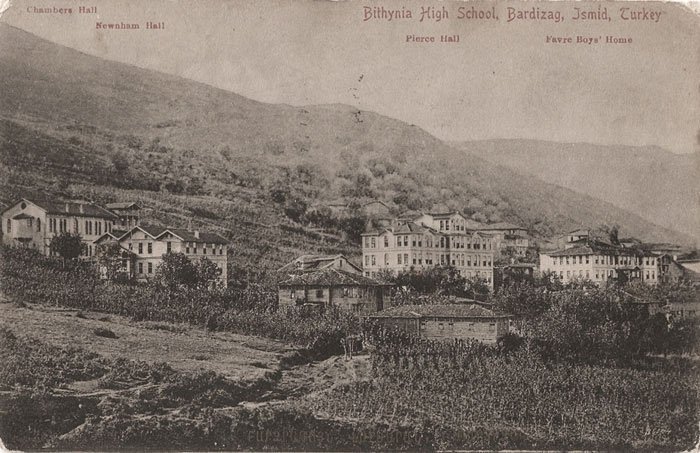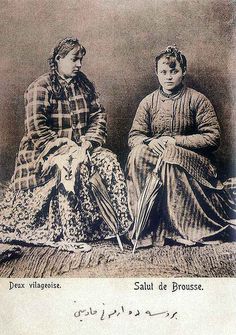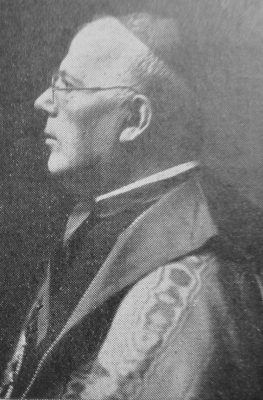Toponym
The history of the settlement dates back to the 10th century or the Byzantine Empire; its original name was Basileia. The immigration of Armenian refugees took place in the 16th or 17th century. They renamed the settlement Bardizag (Eastern Armenian: Partizak – Պարտիզակ – ‘Little Garden’).
Population: 9,000-12,000
“To the south [of Izmit], the little town of Bağçecik (Armenian: Bardizag), with its 9,024 inhabitants, was the last station on the steamboat line that ran between Izmit and the capital Constantinople. Located six kilometers from the coast near Mt. Minas and surrounded by forests and fertile farmland, Bardizag was known above all for its production of silkworms, its vineyards, and its truck gardens. A large American mission, with a middle school and hospital, was active in the town on the eve of the First World War.”[1]

“The name Bardizag was given to a group of eight small villages in the province of Izmit (Nicomedia). Five of these villages were populated by Armenians, one by Greeks, and two by Muslims. At the turn of the century, Bardizag had a predominantly Armenian-speaking population of 10,500 (Der Hagopian 1960: 32), hence the Armenian name, meaning ‘little garden’. Bardizag borders the Sea of Marmara in northern Turkey, not far from Constantinople. The town was founded in the 17th century by Armenians fleeing from their original village Bardizag in Sebastia [Sivas] which at the time, had become a battlefield in the Turco-Persian war.
The favorable geographical location of the new Bardizag on the wooded hillside slopes with its salubrious sea air, charming stone houses, and picturesque flower gardens, made it an attractive summer resort for the wealthy Armenian intelligentsia from Constantinople and environs. Bardizag was known not only for its natural physical beauty, but also for its vibrant cultural life, with eight Armenian schools (including a college), several Armenian churches representing three Christian denominations (Apostolic, Catholic, and Protestant), at least three Armenian newspapers and periodicals, and a lively amateur theatre. Bardizag was also known for its fine medical and pharmaceutical services, and for its many good physicians and pharmacists. Despite its modest size, Bardizag was a hive of literary activity, where both oral and written Armenian were held in high esteem. In short, the stimulating environment of Bardizag was representative of the Armenian literary and cultural revival in 19th century Anatolia.”
Source: Sakayan, Dora: An Armenian Doctor in Turkey: Garabed Hatcherian: My Smyrna Ordeal of 1922. Montreal: Arod Books, 1997, p. IX
More Praise of Bardizag
“The town was established in the sixteenth century by seven Armenian families from Bardizag village in the province of Sivas. Fleeing from the Jelali raids, they settled in what became the western end of Bardizag and were later joined by several Muslim families also escaping from the Jelalis. A second wave of Armenians, consisting of nineteen families from Sivas and Agn arrived in Bardizag early in the seventeenth century. It is said that the Muslims of Bardizag had come with the expectation to work on a large estate of a prominent landowner, Khalil Pasha. However, the pasha, who, as tradition had it, was himself of Armenian descent, grew dissatisfied with the way the Muslim immigrants worked and expelled the lot of them, instead showering his favor upon the Armenians. (…)
Recruiting Maidservants from the Bursa Province for Constantinople: Excerpt from Grigor Zohrap (1861-1915): The Slut
The Slut
1.
After 15 days of efforts, Hadja(2) Tyurik, the mediator of maidservants, finally succeeded in finding the desired stewardess for Mrs. Surbik, wife of Ghazar from Kayseri and one of the richest women of Kadıköy. The Hadja, a woman from Bardizak, was herself a maid, nurse, laundress and cook in her time, according to the need. In the Armenian houses of Polis(3), she had passed through all the official positions and attained her present independent position thanks to the modesty attributed to her. In all the houses, even before she went on pilgrimage to Jerusalem and became a hadja, Hadja Tyurik, as a true and perfect servant, had got to know everyone, from the head of the house to the servant, when young and old, almost without exception, in the absence of the mistresses of the house, had groped her here and there in the rooms, on stairs, behind doors and sometimes in the corners of the kitchens. In many houses she had thus aroused the jealousy of the mistresses, without ever complaining.
She had experienced many things in her own person and even more in her surroundings. Her slender, interesting nose smelled spoilage, and with her sharp hearing she could hear even the quietest conversation behind the doors.
She was already a mature woman when she set off for Jerusalem with the gifts she had received and an increased monthly salary – whether for pilgrimage or penance is a matter of doubt. After her return, she gave up further work as a maid, became self-employed and arranged maids for houses looking for them. She became a broker. She was successful because she was quick-witted and sociable and knew how to tell scandalous stories about the employers. Everyone was satisfied with her. Only she was able to find suitable maids: The girls she placed stayed at their posts for years. The respectable, rich houses turned to her. Her clients boasted that they had her as a go-between:
“Our intermediary is Hadja Tyurik!”
“Ours too!”
The Hadja was something like a mirror for the Armenian women. It was precisely for this reason that Mrs. Surbik had approached her to employ another maid in addition to Mariam, who had been with her for a long time, and whose desired qualities she described in detail to the mediator:
“Above all, she should look pretty! It doesn’t matter if she is not yet up to the task at the beginning. With us she will soon learn what to do. She doesn’t have much to do. She is supposed to tidy up my son Onnik’s room, clean his clothes. And I might add: I don’t want a daughter in the house!”
To underline her intention that the future maid should be limited only to tidying and cleaning Onnik’s clothes, she added: “I don’t need a pampered and refined thing! You understand me, Hadja? If you satisfy me, you’ll get more than your usual referral fee!”
“I understand, my daughter!”
The mediator was an experienced woman. Immediately she turned to all sorts of people, asked, searched, but the ones she found did not meet the conditions Mrs. Surbik had set. There was no shortage of beautiful maids, but they were too experienced and too pampered and cunning enough to drive Mrs. Surbik’s old husband out of his mind. What Mrs. Surbik had in mind was a naive thing, and finding one was not easy in Constantinople.

So Hadja Tyurik set off on her own to Izmit, Bahςecik, Arslanbek, Adapazarı. After all, she had been to all the places from which maids were exported, and after much effort, at dawn on a Wednesday, she triumphantly presented Mrs. Surbik with the barely 18-year-old maid she had brought with her from a village near Bahςecik on the same day.
Mrs. Surbik examined the newcomer, who stood greeting in the doorway, from head to toe. In contrast to her ugly linen skirt, she found her very charming, especially since she also quickly agreed with the intermediary on the monthly salary of seven Piasters and two dresses a year, not counting the dresses discarded by Mrs. Surbik, which she would give her as an additional gift if she was satisfied with her service. In order to start work immediately, she gave her a neat and clean dress, tied a white apron around her, took away her delicate headscarf and gave her a nice hairdo. The beauty of the maid’s hair was shown to its best advantage in such a tight finery. Her waist was not thin, but it corresponded to her height. Though she came from the country, her big black eyes in the pale oval face, under high arched brows sometimes looked haughty. The corners of her mouth, which seemed to be deliberately raised, appeared irresistibly flirtatious and made forget the bloodlessness of her lips. (…)
Arrests, Deportation and Final Flight 1915-1922
“A certain Ibrahim Bey, who had distinguished himself as a Turkish komitacı in the Balkan battles, had also played a role in Adana in 1909, and was now a prison warden in Constantinople, was sent to the main localities of the Vilayet Izmit, to Izmit, Adapazarı, Bahçecik and other places to conduct arrests and search for weapons (three years ago the same Ibrahim Bey had distributed weapons to the Armenians in the same district on behalf of the Young Turk Committee!). As far as weapons were available, the Armenians had already handed them over voluntarily. When further weapons were not found, the notable Armenians were put in prison and tortured there. In Bahçecik, Ibrahim Bey had 42 Gregorian Armenians, including a priest, arrested and beaten to death. He also threatened to burn the place down and to deal with the inhabitants as he had done (in 1909) in Adana.”
Excerpted and translated from: Zurlinden, Samuel: Der Weltkrieg. Vorläufige Orientierung von einem schweizerischen Standpunkt aus. Vol. 1.: Zürich: Art. Institut Orell Füssli, 1917
“In August 1915, the inhabitants of Bardizag were notified of the orders for deportation. This had been preceded by the arrest of forty-two notables, extensive searches for hidden arms, and beatings by the gendarmes. Hundreds of Armenian women from Bardizag who worked in Constantinople as servants and laundrywomen streamed back to their hometown to be with their families once the deportations commenced. Pleas made by the Mekhitaris tpriests for the German government to intercede on behalf of the people of Bardizag were met with a blunt two-worded response: ‘completely hopeless’ (völlig aussichtslos).
The Constantinople Mkhitarists to the German Embassy of Constantinople
Private Letter
Pera, 7 August 1915
Some cases of Armenian deportation
The danger of deportation is approaching the capital. It is at the door. The towns of Eskişehir and Adapazar (Note Mordtmann: the statement concerning Eskişehir has not been confirmed; on the other hand Sabandja, Kurtbelen, Geive [Geyve] have been completely evacuated, churches converted into mosques, church towers into minarets.) have already been deported. All preparations have also been made in Nikomedia or Ismidt [Izmit]. The purely Armenian village Bardizag or Baktshedjik [Bahçecik], which is not far from Nicomedia and has about 12,000 inhabitants, has received the order to prepare itself for deportation. We have seen with our own eyes that hundreds of women from this village, who worked in the capital [Constantinople] as servants and laundresses for the entertainment of their families, left Constantinople in tears the day before yesterday in order to ease the cruel fate of their daughters and children and die with them.
The inhabitants of this poor village were already severely tested about 20 days ago. The central government had given Mr Ibrahim Bey – the prison master of Constantinople and the former organizer of the massacres of Adana in 1908 [1909] – the special task of harassing the Armenians of the entire province of Nicomedia and the nearby towns and villages. Ibrahim Bey first came to Baktshedjik, had 42 respected people of the village brought before him, demanded the weapons which were faithfully delivered to him. He demanded even more than they did not possess. Then, under terrible threats, he beat some of these people, among them the village priest, with his own hand, and when he got tired, he let the others bastardly bastardize by gendarmes, so that some fell unconscious and the others splashed blood from their feet. He had excavations made in the church to find ammunition, which he certainly did not find, because something like this never existed in this village. Ibrahim Bey subjected the villages of Owadjik [Ovacik], Arslanbek and others to a similar procedure. (…)
Source: Political Archives of the German Foreign Office (PA/AA); http://www.armenocide.net/armenocide/armgende.nsf/$$AllDocs-en/1915-08-07-DE-006?OpenDocument

A petition of an Armenian, submitted by Msgr. Dolci to the German Embassy on 19 August 1915, indicates that Non-Apostolic Armenians, i.e. Armenian Catholics and Protestants, were indiscriminately deported from Bahçecik:
“Contrary to all promises, on 16th inst., the Catholic and Protestant Armenians of Baktchedjik were also deported. By chance five nuns and three priests remained in Nicomedia and their people were transported by train. We ask you either to send these priests and sisters back to Baktchedjik or have them sent to Constantinople. Also to send the Catholic and Protestant people back to their village or retain them in Eskişehir.”[1]
Source: http://www.armenocide.net/armenocide/armgende.nsf/$$AllDocs-en/1915-08-19-DE-012?OpenDocument
In September 1922, 105 Greek men from Şile were marched to a Turkish village just outside of Bahçecik where they were to be slaughtered but locals complained. They were taken to a nearby field, unclothed and slaughtered with knives. One male survived.
Source: The Exodus, Center of Asia Minor Studies, Volume A. Athens 1980, p. 344. https://www.greek-genocide.net/index.php/overview/documentation/list-and-map-of-massacres?highlight=WyJcdTAxNWZpbGUiXQ==